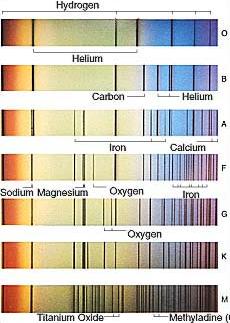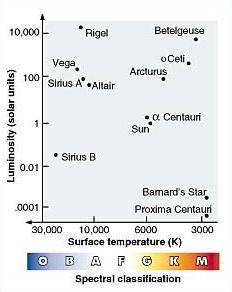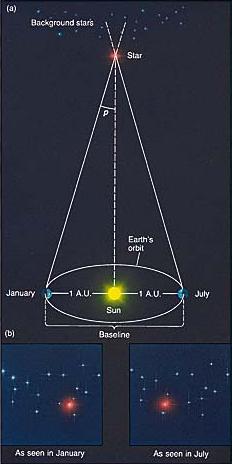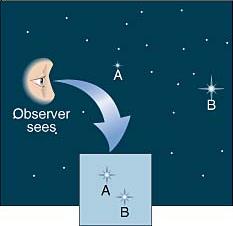Temperature and Classification
- What distinguishes one star from another? Mainly temperature and luminosity (size is related to those quantities); And to some extent, chemical composition.
- Temperature from spectrum: Look at the wavelength of the brightest part (or the absorption lines); example of the Sun.
(One can also get it from the color index, which is not affected by the star's velocity.)
- Temperature range: It usually ranges from 3,000 K to 50,000 K [but colder stars are being found, and classified as L and T; others seem to be as hot as 75,000 K!].
- Spectral Type/Class: Based on the intensity of some spectral lines, classes labelled by letters A, B, C, D, E, F, etc, were introduced. It then turned out that those classes corresponded to temperatures, and that the correct order was O-B-A-F-G-K-M (each from 0 to 9), in order of decreasing T.
- Examples: The Sun, at 6000 K, is a G2 star; [Betelgeuse 3000 K, M2; Arcturus 5000 K, K2; Procyon 7000 K, F5; Sirius 10000 K, A1; Rigel B8; others 30,000 K].
- The HR diagram: A plot of luminosity vs temperature; L ranges from about 1/10,000 to 100,000 times the Sun's luminosity, T from about 3000 to 50,000 K. A clear pattern emerges.
- Types of stars:
The Main Sequence, where most stars lie; It includes blue supergiants, giants, Sun-like stars, red dwarfs.
Other Liminosity classes include supergiants (Ia & Ib), giants (II, III), IV, Main sequence (V), below the MS, white dwarfs
|

 |





![]()